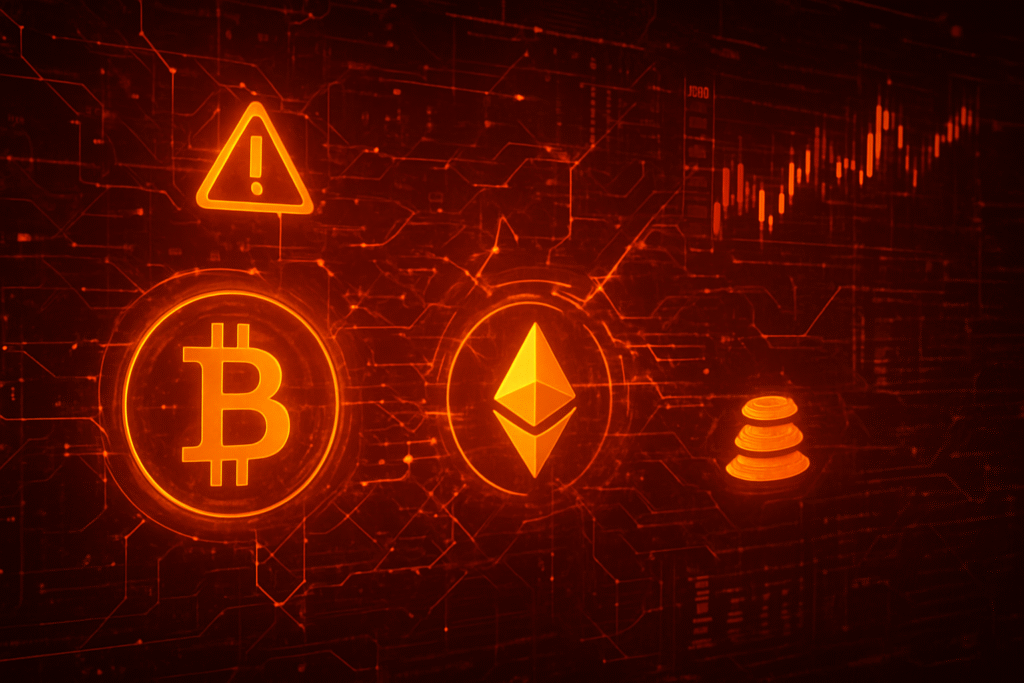
November 3, 2025 – In a severe blow to the decentralized finance (DeFi) ecosystem, the Balancer crypto protocol was subjected to a sophisticated exploit today, resulting in the theft of an estimated $128.6 million in digital assets. The multi-chain attack, which targeted Balancer V2 pools across Ethereum, Base, Polygon, Arbitrum, Optimism, and Sonic, has sent immediate shockwaves through the crypto community, raising renewed concerns about smart contract security and the interconnected risks within DeFi.
The exploit, identified as a faulty smart contract check or an access control vulnerability within Balancer's "boosted pools" and the "manageUserBalance" function, allowed the attacker to illegitimately withdraw substantial amounts of wrapped Ether (WETH), osETH, and wstETH, among other tokens. Initial reports placed losses around $70 million, but the true scale quickly escalated as the full extent of the multi-chain breach became clear. The immediate market reaction saw Balancer's native token, BAL, experience a sharp decline, dropping over 4% as news of the exploit spread. This incident, occurring on the very day of this report, serves as a stark reminder of the persistent security challenges facing even established DeFi protocols and underscores the critical need for continuous vigilance in the rapidly evolving Web3 landscape.
Market Impact and Price Action
The $128 million Balancer hack, the largest in the protocol's history and one of the most significant DeFi exploits of 2025, triggered an immediate, albeit somewhat contained, reaction in the broader crypto market. Balancer's native token, BAL, saw its price dip by over 4% following the announcement, with some reports indicating a 5% drop. However, it's worth noting that BAL has historically traded on low volumes and has experienced a significant long-term decline since its launch. This suggests that while the hack contributed to immediate selling pressure, it may have exacerbated existing market sentiment rather than causing a singular, catastrophic crash from a position of strength. For context, a smaller, $1 million exploit in August 2023 led to a more substantial 20.81% decline in BAL's price over 30 days, indicating that the token's sensitivity to exploits has varied.
The most profound impact was felt in Balancer's Total Value Locked (TVL) and liquidity. Prior to the exploit, Balancer managed over $700 million in total assets, with over $350 million in TVL on Ethereum alone. The protocol's TVL was already at $678 million, a significant drop from its 2022 peak of $3.11 billion. The current $128 million exploit is expected to further depress these figures as users, advised by security firms and community members, swiftly withdrew funds from affected pools. This "bleeding" of funds highlights the direct correlation between security incidents and liquidity erosion, as investor confidence directly translates to capital allocation.
The exploit's multi-chain nature meant that its impact was not confined to a single network. Affected chains included Ethereum, Berachain, Arbitrum, Base, Sonic, Optimism, and Polygon. The stolen assets, primarily wrapped ETH (WETH), liquid staking derivatives like osETH and wstETH, underscored the vulnerability of these high-value, interconnected assets. Approximately 6,587 WETH ($24.5 million), 6,851 osETH ($26.9 million), and 4,260 wstETH (~$19.3 million) were drained. This incident adds to a troubling year for crypto security, with over $3 billion already stolen in 2025, following a $91 million Bitcoin scam in August and a $2.5 million Moby exploit in January. Balancer itself has a history of security breaches, including a $500,000 flash loan attack in 2020 and a $1 million vulnerability in its boosted pools in August 2023, even after public disclosure. This latest attack, however, is by far its most significant, reinforcing the persistent and evolving threat landscape in DeFi.
Community and Ecosystem Response
The Balancer hack immediately triggered a torrent of activity and concern across the crypto community. On social media platforms like X (formerly Twitter) and Reddit, sentiment was dominated by caution and a strong emphasis on user safety. Security firms such as PeckShield and Nansen were quick to confirm the breach and issued urgent advisories, strongly recommending that users revoke any Balancer-related token approvals and meticulously monitor their wallet activity. Community discussions on Reddit echoed a prevailing sentiment that DeFi protocols must drastically improve their security posture to achieve mainstream adoption, with many reiterating the stark truth that "audits don't equal immunity." The immediate aftermath saw approximately $400 million in withdrawals from Balancer's Total Value Locked (TVL) within hours, signaling widespread panic selling and a rapid flight of capital.
Crypto influencers and thought leaders also weighed in, expressing deep concern about the hack's broader implications. Hasu, Strategic Director of Flashbots and Strategic Advisor to Lido, articulated a widely shared view that such significant exploits in established protocols like Balancer "set DeFi adoption back by 6 to 12 months." While some broader market commentary was present, the direct reactions highlighted the fragility of trust in the DeFi space. The incident served as a potent reminder that even protocols with multiple audits can fall victim to complex smart contract exploits, pushing thought leaders to emphasize the critical importance of continuous vigilance and robust risk management.
The ripple effects of the Balancer hack extended swiftly across the wider DeFi ecosystem. Several Balancer forks, including Beets on the Sonic Chain and Beethoven on the Optimism blockchain, were also impacted, underscoring a shared vulnerability in their codebase. Notably, Berachain, a Cosmos-based Layer 1 blockchain, took decisive action by proactively halting its network and initiating an emergency hard fork. This measure aimed to address potential risks to its ecosystem and recover user funds, particularly those within its Ethena/Honey tripool on the Berachain Exchange (BEX). Berachain's Chief Smokey Officer, Smokey The Bera, acknowledged the controversial nature of pausing the network but stressed its necessity to protect an estimated $12 million in user deposits. Lido, another prominent liquid staking derivative protocol, proactively withdrew its unaffected positions from Balancer to mitigate any further exposure. The incident also prompted a broader de-risking trend among traders, leading to increased sell pressure on major cryptocurrencies like Ethereum ($ETH), Solana ($SOL), and BNB ($BNB), contributing to a general market downturn with nearly $470 million in crypto positions liquidated. In contrast, BNB Chain confirmed none of its projects were affected, deploying real-time network monitoring and advising forked projects on its chain to pause operations as a precaution, which helped maintain community confidence in its ecosystem.
What's Next for Crypto
The $128 million Balancer hack, occurring on November 3, 2025, serves as a critical inflection point for the crypto market, particularly the DeFi sector. In the short term, we can expect continued market volatility and a period of heightened caution among investors. The immediate focus will be on Balancer's response, including any potential recovery efforts or reimbursement plans, and the full extent of the fallout on its various forks and interconnected protocols. The incident will likely fuel further de-risking by traders, potentially leading to a "flight to quality" as investors seek more secure and audited platforms.
Looking ahead, the long-term implications are significant. This hack will undoubtedly accelerate the industry's push for more robust security standards. Traditional, one-off audits are increasingly being recognized as insufficient, paving the way for multi-layered security protocols, continuous real-time monitoring, and more comprehensive bug bounty programs. Projects that prioritize and visibly invest in security will likely gain a competitive edge and attract greater capital. From a regulatory standpoint, this incident will almost certainly intensify calls for clearer and stronger frameworks. While the EU's MiCA regulation has taken effect, it currently excludes fully decentralized DeFi protocols, a gap that regulators will likely seek to address by 2026. Stricter cybersecurity reporting requirements, such as those coming into effect in the US from October 2025, will become even more critical.
Potential catalysts and developments to watch include the rapid advancement of AI-powered auditing tools, which could significantly reduce the time and cost of security reviews, identifying vulnerabilities in seconds. The maturity and adoption of decentralized insurance solutions, such as Nexus Mutual and InsurAce, are also crucial. These protocols are poised to become a vital foundation for sustainable DeFi growth, with the global decentralized insurance market projected to reach $16.94 billion by 2029. Cross-chain security solutions will also be essential, given the multi-chain nature of many exploits. For projects, strategic considerations must revolve around prioritizing comprehensive security audits, implementing multi-layered defenses, developing robust incident response plans, and fostering transparency. Investors, in turn, must conduct thorough due diligence, diversify across chains and asset classes, utilize hardware wallets, consider DeFi insurance, and remain continuously informed about security news. While continued, smaller-scale attacks are very likely, the industry's response to this hack could lead to increased security maturity and resilience, potentially paving the way for accelerated institutional adoption with enhanced safeguards.
Bottom Line
The $128 million Balancer hack on November 3, 2025, is a stark reminder that even mature and audited DeFi protocols remain vulnerable to sophisticated exploits. For crypto investors and enthusiasts, the key takeaway is the paramount importance of smart contract security. This incident underscores that audits, while necessary, are not a guarantee of invulnerability, and the interconnectedness of DeFi can amplify risks across the ecosystem. Users must be prepared to act swiftly in the event of an exploit, withdrawing funds from affected pools and revoking token approvals. The immediate decline in BAL's price and Balancer's TVL highlights the direct impact on investor confidence and liquidity.
In the long term, this hack will undoubtedly intensify scrutiny on DeFi security, driving demand for more rigorous auditing practices, advanced real-time monitoring, and robust incident response plans. Regulatory bodies are likely to increase pressure for clearer frameworks and mandatory security standards, particularly for decentralized protocols. This could, paradoxically, be a catalyst for improvement, pushing the industry to build a more resilient and trustworthy ecosystem. However, it also presents a significant hurdle for broader crypto adoption, reinforcing the perception of DeFi as a high-risk sector, particularly for institutional investors and mainstream users.
Moving forward from November 3, 2025, several critical metrics and events bear close monitoring. Balancer's official communications regarding the investigation, recovery plans, and potential reimbursement will be crucial. Watch for detailed reports from blockchain security firms like PeckShield, Cyvers, and Nansen, which will offer deeper insights into the exploit's mechanics. The TVL and BAL token price will serve as key indicators of investor confidence and the protocol's ability to recover. Furthermore, observe the actions of affected protocols and chains, such as Berachain's emergency hard fork, and the wider DeFi community's response in developing new security measures and standards. Any regulatory statements or actions concerning DeFi security in the wake of this and other major hacks will also be significant. Finally, the performance and adoption of decentralized insurance protocols will be an important metric, as demand for such services is expected to increase, potentially fostering greater confidence in the face of persistent risks.
This article is for informational purposes only and does not constitute financial or investment advice. Cryptocurrency investments carry significant risk.





